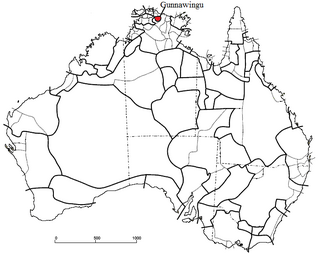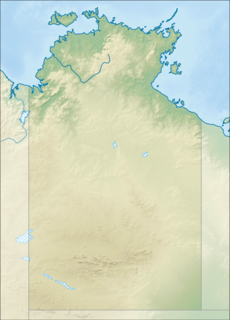This page is based on this
Wikipedia article Text is available under the
CC BY-SA 4.0 license; additional terms may apply.
Images, videos and audio are available under their respective licenses.

The Yolngu or Yolŋu are an aggregation of indigenous Australian people inhabiting north-eastern Arnhem Land in the Northern Territory of Australia. Yolngu means "person" in the Yolŋu languages. The terms Murngin and Wulamba were formerly used by some anthropologists for the Yolngu.
All Yolngu clans are affiliated with either the Dhuwa (Dua) or the Yirritja moiety.
Gurr-goni, also spelled Guragone, Gorogone, Gun-Guragone, Gunagoragone, Gungorogone, Gurrogone, Gutjertabia, is an Australian Aboriginal language spoken in Arnhem Land. There were about 60 speakers in 2011, all trilingual in Burarra or Gunwinggu.
The Burarra, also referred to as the Gidjingali, are an indigenous Australian people in and around Maningrida in the Northern Territory. Opinions have differed as to whether the two names represent different tribal realities, with the Gidjingali treated as the same as, or as a subgroup of the Barara, or as an independent tribal grouping. For the purposes of this encyclopedia, the two are registered differently, though the ethnographic materials on both may overlap with the other.

The Gunwinggu people are a tribe of Australian Aboriginal people, forming part of the Bininj Gun-Wok peoples, who live to the east of Darwin, Northern Territory.
Burarra is an Australian Aboriginal language spoken by the Burarra people of Arnhem Land. It has several dialects.
The Madngella, otherwise known as the Matngala or Hermit Hill tribe, are an indigenous Australian people of the Northern Territory, Australia.
The Nunggubuyu are an indigenous Australian people of eastern Arnhem Land in the Northern Territory.
The Warndarang (waɳʈaraŋ) were a predominantly coastal indigenous Australian people of eastern Northern Territory. Though extinct as a distinct ethnolinguistic group, their descendants survive among the neighbouring Nunggubuyu
The Djinang are an indigenous Australian people of the Northern Territory.
The Djinba are an indigenous Australian Yolngu people of the Northern Territory.
The Yan-nhaŋu, also known as the Nango, are an indigenous Australian people of the Northern Territory. They have strong sociocultural connections with their neighbours, the Burarra, on the Australian mainland.
The Gadjalivia were an indigenous Australian people of Arnhem Land in the Northern Territory. They are now regarded as extinct.
The Nagara, also written Nakara, are an indigenous Australian people of Arnhem Land in the Northern Territory.
The Wadjiginy, also referred to historically as the Wogait, are an indigenous Australian people of the Northern Territory.
The Gambalang were an indigenous Australian people of the Northern Territory.
The Gungorogone are an indigenous Australian people of the Northern Territory.
The Ngardok were an indigenous Australian people of the Northern Territory. Nothing is known of the language, which has been extinct since about WW2.
The Djerait were an indigenous Australian people of the Northern Territory
The Ngolokwangga are an indigenous Australian people of the Northern Territory.






